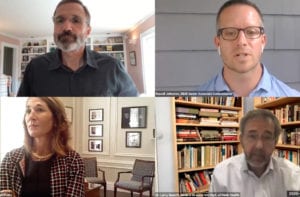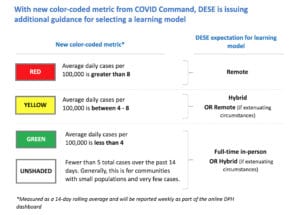Who is a member?
Our members are the local governments of Massachusetts and their elected and appointed leadership.

State leaders and municipal CEOs from across the state convened on Zoom to discuss reopening of schools and new weekly case data. Pictured are (clockwise from top left) MMA Executive Director Geoff Beckwith; Russell Johnston, senior associate commissioner at the Department of Elementary and Secondary Education; Dr. Larry Madoff, medical director at the Bureau of Infectious Disease and Laboratory Sciences at the Department of Public Health; and Lt. Gov. Karyn Polito.)
Just moments after the administration unveiled a new COVID-19 measure that assigns a color code to each community signifying its caseload, state and local leaders discussed the implications for the new metric for reopening schools and attacking the spread of the disease in Massachusetts.
The administration released a map indicating which communities are higher risk, moderate risk, or lower risk for spreading the novel coronavirus – with corresponding colors of red, yellow and green – based on their average daily case rate per 100,000 people, using a 14-day rolling average.
The four red communities – Chelsea, Everett, Lynn and Revere – have more than eight cases per 100,000 people. Twenty-nine yellow communities have between four and eight cases per 100,000, and 76 green communities have fewer than four cases per 100,000. The remaining 242 communities, primarily small towns, have fewer than five cases in total, and are identified in white.
In a conference call with more than 200 municipal officials – the 18th in a series of regular calls with high-level state officials convened by the MMA during the COVID emergency – Lt. Gov. Karyn Polito called the 318 communities that are either green or white “a powerful number” marking the state’s progress in fighting COVID, and called the combined 33 red and yellow communities that need to see improvement “a manageable number.”
State officials are urging people living in moderate- and high-risk communities to closely follow coronavirus safety precautions, including avoiding social gatherings, maintaining 6 feet of distance, and wearing face coverings. Polito said the state’s contact tracing program can help local officials identify the origin of cases in order to facilitate progress from red to yellow and from yellow to green. She added that the state would be focusing resources on helping the 33 red and yellow communities.
State officials said the data and map will be updated each Wednesday, beginning tomorrow, on its Daily Dashboard.
School reopening
 The Department of Elementary and Secondary Education announced today that it is using the new color codes to recommend a learning model for school districts this fall.
The Department of Elementary and Secondary Education announced today that it is using the new color codes to recommend a learning model for school districts this fall.
DESE Senior Associate Commissioner Russell Johnston said his department is recommending full-time, in-person learning for the 318 communities classified as either green or white.
A hybrid model – a blend of in-person and remote learning – is recommended for the 29 yellow communities: Auburn, Belchertown, Boston, Brockton, Charlton, Chicopee, Fall River, Framingham, Georgetown, Granby, Holyoke, Hull, Lawrence, Longmeadow, Malden, Marlborough, Maynard, Middleton, Northampton, Peabody, Quincy, Randolph, Salem, Saugus, Springfield, Taunton, Winthrop, Worcester, and Wrentham.
A remote learning model is recommended for the red communities. A district may downgrade to a lower learning model if it faces “extenuating circumstances,” such as building conditions, Johnston said.
With input from health experts, DESE continues to place an emphasis on bringing children back into classrooms to the greatest extent possible.
“We want to get back to what we know is best for kids,” he said. “We believe that with the right health and safety features in place – wearing masks, maintaining physical distance, good hand hygiene, and staying … at home if you’re sick – the combination of those four factors make our schools safe to be at in person. And that’s why we really want to lean in on reopening our schools and having as much in person instruction as possible, while also recognizing that it might be something that we have to grow toward as the school year resumes.”
School districts have until Friday to notify the DESE of their choice of learning model, and many school committees have already made their decisions, following extensive deliberations and public input. Recognizing this, Johnston said his department is urging districts to use the new data to continually assess their position as the school year goes on and the data evolve, and some may wish to revisit their decisions. He added that a city or town’s COVID-positive test rate – particularly whether that number is rising or falling – is another factor to consider in decision-making.
The DESE is also urging districts to prioritize in-person services for the “most vulnerable” students – those with disabilities and special needs – even if they select a hybrid or remote model for the district as a whole.
“There are some legal consequences to students not getting a ‘free and appropriate’ public education,” he added.
Johnston said DESE “will have more information for you on [school-based COVID] testing very soon,” adding that it would be “positive and helpful news.” Asked about the appropriate response to a COVID-positive case in a school, Johnston said there were a small number of cases in residential programs that stayed open throughout the pandemic as well as summer school programs, but not a single school was closed in response.
“When you think about the many, many, many people we have involved in our schools, we will have cases,” he said. “And we need to take the attitude that these will occur, and we can find our way through them.”
He said conversations at the local level about this reality and the plans and protocols in place to deal with it “will help take down the pressure” when a case does occur.
Dr. Larry Madoff, medical director at the Bureau of Infectious Disease and Laboratory Sciences at the Department of Public Health, said the department is working with DESE to update its guidance regarding contact tracing specifically for school-age children.
On the popular topic of school sports, Johnston said guidance will be coming “very, very soon” and that it will likely align with guidance for outdoor activities from the Executive Office of Energy and Environmental Affairs and will reflect input and support from the Massachusetts Interscholastic Athletic Association.
He said the department is also working on guidance updates to address instances when students or staff come into a district from a community with a higher COVID rate. And he referenced the guidance for student transportation issued by DESE last month.
Making adjustments
Lt. Gov. Polito reviewed changes made to the state’s rules governing gatherings and restaurants, effective today, and the decision to put a hold on Step 2 of Phase 3 of the state’s reopening plan.
“It is summer, and we have these few months of the year that we love to enjoy,” she said. “And there are some people that are just enjoying it a little too much, in terms of activity that is not distant, doesn’t include a [face] covering and choices that some people are making that are leading to [COVID] spread.”
State and local police are now empowered to help local health departments enforce the revised outdoor gathering limit of 50 people for a single event on either public or private property. The state is also creating an interagency enforcement and intervention team, which will target its work in communities with higher-than-average COVID rates (designated red and yellow).
Regarding restaurant rules, Polito said, “We went more after the bars that were trying to say that they were a restaurant, but they really were just serving drinks with no real food, and we updated some guidance there.”
Restaurants, she added, are not subject to general gathering limits, but must comply with industry-specific guidance. The gathering limit applies, however, when a venue hosts a single event, such as a wedding.
The state’s 17 Stop the Spread free testing sites have conducted more than 50,000 tests and will remain open through Sept. 12, and possibly longer. Polito said these sites may be a resource for Massachusetts residents returning from states designated as non-low-risk under the state’s travel order and want a negative test result in order to return to work.
Polito said the state will be updating its travel order information now that a bordering state, Rhode Island, has been added to the list of non-low-risk states. She also referenced the state’s human resources policy regarding voluntary travel by employees and their return to work.
• Audio of Aug. 11 call with administration (40M MP3)
• COVID-19 Executive Order No. 48, Amending the Administration of Penalties Issued Pursuant to Certain COVID-19 Orders (e.g., Travel, Gatherings, Face Mask, & Reopening Orders) – Aug. 18
• Dept. of Elementary and Secondary Education, Overview of Metrics (68K PDF)
• Guidance for Districts and Schools on Interpreting DPH COVID-19 Metrics, Dept. of Elementary and Secondary Education (406K PDF)